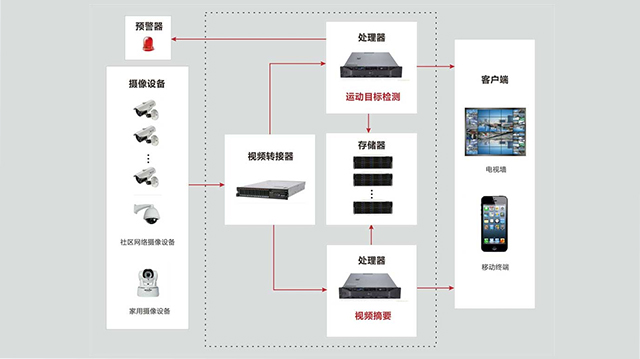Along with the rapid development of the Chinese economy, society's development and financial capacity rises, while social security is increasingly more complex and this leads to the people's demand for increased security needs, not only at property level, but also safety aspects and more importantly also the need for personal security. The market necessitates a strong need and this higher demand calls for more professional service. Network monitoring and alarm systems are created according to the needs of multi-party requirements and also technology improvements.
Network monitoring and alarm systems technology is a new generation of alarm technology which has been developed in recent years. Compared with the traditional alarm technology, the new alarm technology not only realizes the visualization of the alarm, but is also more intelligent and integrates seamlessly with the Internet application, which then becomes a part of for the visual networking alarm market. This will then elevate the network monitoring and alarm systems market into a new era.

Introduction to China Cityguard's Networking Monitory Alarm Technology
The Network Monitoring Alarm system of China Cityguard is a new type of alarm technology that uses video as the source of alarm and analysis technology in detection. The system works when the condition is met and launches the alarm when the setting condition is triggered.
The core of the Networking Monitoring Alarm System is its video analysis, which separates the background and the target in the scene by a video algorithm, analyzes and tracks the subject in the scene of the camera, completely tracking and analyze the subject's behavior, while automatically sending alarm data through the preset requirement, and prompts the user to make a decision and take necessary measures..

Characteristics for visualization of China Cityguard's Networking Monitor Alarm Technology
Characteristics
During an incident occurring, the live real-time image (picture + video) before and after the alarm activation will be automatically uploaded to the Call Service Center and to the User mobile, making the alarm both intuitive and visual. For the Call Service Center, the exact case situation is accurately determined via real-time imagery, minimizing manpower and material resources usually associated during a false alarm where costs and alarm evidence is present. Simultaneously, the visualization allows users to master the self alerting alarm information any time, determining accurate evaluation of security service.
Fewer Negative Certainties
The network video alarming technique adopts intelligent video analysis algorithm and background replication technology, and is matched with a high-precision target tracking algorithm to improve the accuracy of the alarm. In addition, by analyzing the subject's behavior, any activation by a pet, dust, leaf, insects, wind or other interferences such as cats and dogs are eliminated, and the problem of negative certainties caused by environmental interference is reduced, and the negative alarm rate can be reduced to a minimum of 10%.
Integrated Multiple Alarms
The video alarm supports the same camera to access a variety of alarm modes, including fire and smoke, theft and detention, off-duty alarm, behavior analysis alarm (straying, movement anomaly, disturbance), etc...
System Self-Checking
The network video alarm technology can automatically detect the equipment operation, and when the camera experiences video blurring, lens anomaly, etc.., the system automatically reminds the user or sounds an alarm to ensure that the equipment is maintained in optimum status, ensuring safe management.
Internet Applications
Linked to a effective internet, the network video alarm technology fully supports Internet applications, enabling remote video real-time viewing, alarm settings and deployment and extraction operations, and supports large data and cloud services.
Integration of Variety of Technologies
Network video alert technology is not just solitary technology, it integrates video analysis, Internet, cloud computing & platform, Internet of things, biometrics, wireless communication, embedded technology, software technology, infrared technology, GPS/ GIS, mobile terminal application, etc., breaking through single Security services to provide comprehensive security and personalized services to users.